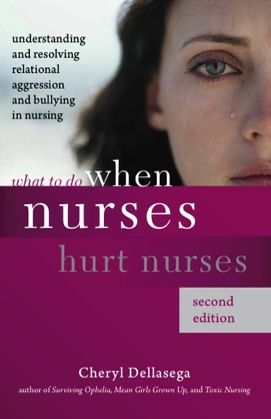Nurse Practitioner / Educator / Author / Speaker / Relational Aggression Expert


I wrote about my experiences with nurses who are bullies in my first book Critical Care, and for the New York Times “Well” blog, as an observer and victim, but Dellasega writes as an analyst, offering an evidence-based understanding of the problem along with tools to help make it better. When Nurses Hurt Nurses points out that competition between nurses is often what motivates RA: “In the ICU and ER, nurses jockeyed for recognition as the smartest and most accomplished 'supernurse.'” (p. 21) That competitiveness was at least part of what led to me being bullied: “ordinary” nurses could not compete with PhD-nurse/me so they worked to undermine me. I was not trying to compete with the other nurses on the floor, but they still used RA to handle the stress of working with me—making the hospital floor unpleasant for all of us.
Work environments with rampant RA, or even pockets of it, lead nurses to quit their jobs. Between 40-50% of nurses are burned-out, according to the most recent statistics, and one in five new nurses, or 20%, leaves his or her first job within a year. Despite hearing constant warnings about a looming nursing shortage, we are still, as a profession, not ensuring that new nurses will be on the job and thriving when older nurses retire. Clinical nurses and nurse managers need to realize that work environment is key to nurse retention, as Dellasega writes: “From the moment you start a new job, the quality of your work relationships is a key factor in whether you stay or leave. Indeed, more than one study has linked workplace hostility with burnout and leaving a job.” (p. 23)
The solution to RA outlined in When Nurses Hurt Nurses is what Dellasega calls “The E-R-I Model of Behavior Change,”: Educate, Relate, Integrate. The steps are not complicated, but they can be emotionally demanding. Frontline nurses, and particularly Nurse Managers, need to remember the times in their career when they experienced RA, figure out how those experiences shaped the nurse they are now, and then imagine different, better, behaviors. Nurses must make peace with the trauma of past RA in order to put new models of open communication and genuine collegiality in place.
Stories about RA fill the book and they made me cringe at how mean nurses can be to other nurses, but they also made me sad because they suggest that nurses put more effort into bringing each other down instead of lifting each other up. Identifying the problem of RA is the first step to changing it, and the several appendices to When Nurses Hurt Nurses have guides for diagnosing RA and responding to it. Dellasega writes with hope: “With effort and collaboration, that old saying, 'Nurses eat their young,' will be replaced by a new common wisdom: 'Nurses know how to treat their young.'” (p. 153) For the sake of all nurses—those ready to retire and those just starting new jobs—may that new common wisdom become nurses' on-the-job reality, and soon. Our patients, after all, need nurses who are as focussed and supportive as an already difficult work environment allows. - Theresa Brown
Nonfiction by Dr. Cheryl Dellasega
Foreword - Theresa Brown (continued from previous page)
What to Do When Nurses Hurt Nurse
“This book is a must-read for all nurses, educators, and students. It identifies toxicity that can be found among nurses and gives the reader a toolkit on how to survive. The readings, coupled with examples and end-of-chapter activities, provide an opportunity for reflection. You don't have to be a victim. You can use the tools in this book to, as Dellasega puts it, educate, relate, and integrate to prevent relational aggression and bullying in nursing.”
–Barbara Broome, PhD, RN, FAAN
Dean and Professor, College of Nursing,
Kent State University
“This book may be the most important nursing resource this decade. Relational aggression negatively impacts nurses' morale, health, engagement, and retention, as well as patient care and outcomes. Dellasega explores the nature of nurse-on-nurse bullying while establishing an action plan for resolving this threat to our honorable profession. Acknowledging that self-care is part of the solution, she offers practical tools that motivate nurses to fulfill their calling: to care for patients, themselves, and each other.”
–LeAnn Thieman
Founder, SelfCare for HealthCare
Author, Chicken Soup for the Soul for Nurses series
“Cheryl Dellasega's book What to Do When Nurses Hurt Nurses, Second Edition, takes an in-depth look at relational aggression—how it shows up in the nursing profession and what actions work best to address it. Using real-life examples and evidence from numerous studies, Dellasega explores gender factors, victimology, and systems that perpetuate the problem. The book closes with an opportunity for nurses to step up as professionals and do their part to foster a positive and professional work environment.”
–Renee Thompson, DNP, RN, CMSRN, CSP
Founder, The Healthy Workforce Institute
https://healthyworkforceinstitute.com
Reviews (continued from previous page)
Helping Women Turn Conflict into Connection

